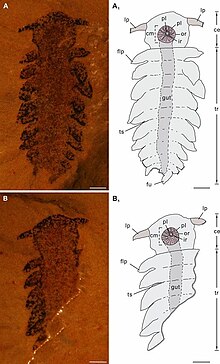小可爱虫属
始祖小可爱虫(学名:Parvibellus atavus)是小可爱虫属(学名:Parvibellus)唯一一个物种,也是模式种。生存在寒武纪第三期。身上具有十一对的扇叶,头部还有两个小的突起物,和一个位在腹侧、圆的口器。[1]是在中国云南省海口镇澄江化石地(Chengjiang Biota)和玉案山山峰( Yu’anshan (Heilinpu) Formation)发现的。[1]属名是由parvus(微小)和bellus(可爱)组成的,因为身体的外观而得名;而种小名-atavus(祖先),是因为这个物种具有很类似于泛节肢动物的体态。[1]目前只发现ELI-EJ048A这个标本。这些身体构造很像叶足动物、欧巴宾海蝎类还有放射齿目的物种,所以始祖小可爱虫的分类可能位在恐虾纲或是叶足动物之间。[1]
| 始祖小可爱虫 | |
|---|---|

| |
| 始祖小可爱虫的化石图片。 | |
| 科学分类 | |
| 界: | 动物界 Animalia |
| 演化支: | 泛节肢动物 Panarthropoda |
| 演化支: | 序足动物 Tactopoda |
| 门: | 节肢动物门 Arthropoda |
| 纲: | †恐虾纲 Dinocaridida |
| 属: | †小可爱虫属 Parvibellus Liu et al. 2022 |
| 种: | †始祖小可爱虫 P. atavus
|
| 二名法 | |
| †Parvibellus atavus Liu et al. 2022
| |

形态
编辑头部
编辑其中类似头部的圆形部分约1.1毫米,最宽的部分为1.38毫米。[1]头部区域的三分之一有一对突起物,那个凸起物有一点点稍微指向后方。[1]既巨大有圆形的口器位在头部区域的腹侧,嘴巴上的两个圆圈都具有一排的牙齿,比较外侧的齿环半径约0.6毫米;比较内侧的齿环半径约0.18毫米。[1]大约有七片齿板在比较外侧的齿环,有几个在比较内侧的齿环,但是发现齿板的化石都没有保存很清楚。[1]
身体
编辑全长大小约5.25毫米;而躯干的部分长约4.07毫米,宽大约是1.1毫米。[1]身体侧面的长的类似扇叶的突起物长约0.51毫米,最宽的地方约是0.26毫米,扇叶的突起物的基部(连接的部分)和末端有稍微变小。[1]身体有十一对类似扇叶的突起物,且平均的分布在躯干上。[1]从身体到扇叶的突起物的连接部分不太明显。[1]扇叶的突起物的轮廓大约是椭圆形或三角形。[1]扇叶的突起物可能像是欧巴宾海蝎类[2][3][4]或是放射齿目的物种[5]用来游泳[1],但是不太可能像是叶足动物的埃谢栉蚕用来当作脚行走。[1][6]
分类
编辑叶足动物
编辑始祖小可爱虫的样子不像叶足动物,因为它缺少了叶足动物应有的细长如蠕虫的身躯。[1]外观最像的叶足动物是埃谢栉蚕[1],因为都有一对前附肢和十对当作脚的叶足[6][7];但是埃谢栉蚕的身体有环纹,而且脚上还有爪子,且叶足动物大多是生活在海底的,而始祖小可爱虫是可以自行游动的生物。[1]再加上比较早期的大多数叶足动物的口器(嘴巴)不是在腹侧[7],但是愈年轻的物种的嘴巴都是在腹侧,像是"具鳃叶足动物",例如:厌恶虫属(Pambdelurion )或是欧巴宾海蝎(Opabinia )或是比较与有爪动物相关的类群,例如:触角棘足虫属(Antennacanthopodia)、三爪虫属(Tritonychus)。[1][8][9]
AOPK群
编辑始祖小可爱虫的扇叶突起物和位在腹侧的口器与恐虾纲(旧称AOPK群[1][10][11][12][注 1])的物种很相似。但是在口器的方面,许多物种的嘴巴位置与始祖小可爱虫不太一样。在身体方面,始祖小可爱虫有十一个扇叶突起物,而大多数恐虾纲物种是八到十个扇叶。头部还有一对看起来是前附肢,这个特征在恐虾纲几乎每个物种都有。特别是放射齿目的物种与欧巴宾海蝎和厌恶虫属及宣扬爪虫。[1]
发育
编辑如果始祖小可爱虫是年幼的放射齿目物种,那口器与眼睛和头部的附肢可能尚未发育成熟,有一个例子反对这样的想法。[1]Cong等人于2012年发表里拉琴虫属(Lyrarapax)[14],过了6年,Liu等人发现了里拉琴虫的幼体化石,在那个幼体的里拉琴虫化石上有完整的眼睛和口器,[15]所以始祖小可爱虫不是放射齿目的物种。[1]
参考资料
编辑- ^ 1.00 1.01 1.02 1.03 1.04 1.05 1.06 1.07 1.08 1.09 1.10 1.11 1.12 1.13 1.14 1.15 1.16 1.17 1.18 1.19 1.20 1.21 1.22 1.23 Liu, Jianni; Dunlop, Jason A.; Steiner, Michael; Shu, Degan. A Cambrian fossil from the Chengjiang fauna sharing characteristics with gilled lobopodians, opabiniids and radiodonts. Frontiers in Earth Science. 2022-07-22, 10. ISSN 2296-6463. doi:10.3389/feart.2022.861934.
- ^ Budd, Graham E. The morphology of Opabinia regalis and the reconstruction of the arthropod stem‐group. Lethaia. 1996-03, 29 (1). ISSN 0024-1164. doi:10.1111/j.1502-3931.1996.tb01831.x.
- ^ Budd, Graham E.; Daley, Allison C. The lobes and lobopods of Opabinia regalis from the middle Cambrian Burgess Shale. Lethaia. 2012-01, 45 (1). ISSN 0024-1164. doi:10.1111/j.1502-3931.2011.00264.x.
- ^ The enigmatic animal Opabinia regalis , middle Cambrian, Burgess Shale, British Columbia. Philosophical Transactions of the Royal Society of London. B, Biological Sciences. 1975-06-26, 271 (910). ISSN 0080-4622. doi:10.1098/rstb.1975.0033.
- ^ Van Roy, Peter; Daley, Allison C.; Briggs, Derek E. G. Anomalocaridid trunk limb homology revealed by a giant filter-feeder with paired flaps. Nature. 2015-03-11, 522 (7554). ISSN 0028-0836. doi:10.1038/nature14256.
- ^ 6.0 6.1 The Lobopod Animal Aysheaia pedunculata Walcott, Middle Cambrian, Burgess Shale, British Columbia. Philosophical Transactions of the Royal Society of London. B, Biological Sciences. 1978-11-16, 284 (1000). ISSN 0080-4622. doi:10.1098/rstb.1978.0061.
- ^ 7.0 7.1 Liu, Jianni; Dunlop, Jason A. Cambrian lobopodians: A review of recent progress in our understanding of their morphology and evolution. Palaeogeography, Palaeoclimatology, Palaeoecology. 2014-03, 398. ISSN 0031-0182. doi:10.1016/j.palaeo.2013.06.008.
- ^ Ou, Qiang; Liu, Jianni; Shu, Degan; Han, Jian; Zhang, Zhifei; Wan, Xiaoqiao; Lei, Qianping. A rare onychophoran-like lobopodian from the Lower Cambrian Chengjiang Lagerstätte, southwestern China, and its phylogenetic implications. Journal of Paleontology. 2011-05, 85 (3). ISSN 0022-3360. doi:10.1666/09-147r2.1.
- ^ Vinther, Jakob; Porras, Luis; Young, Fletcher J.; Budd, Graham E.; Edgecombe, Gregory D. The mouth apparatus of the Cambrian gilled lobopodian Pambdelurion whittingtoni. Palaeontology. 2016-09-26, 59 (6). ISSN 0031-0239. doi:10.1111/pala.12256.
- ^ Liu, Jianni; Shu, Degan; Han, Jian; Zhang, Zhifei; Zhang, Xingliang. Morpho‐anatomy of the lobopod Magadictyon cf. haikouensis from the Early Cambrian Chengjiang Lagerstätte, South China. Acta Zoologica. 2007-04-19, 88 (4). ISSN 0001-7272. doi:10.1111/j.1463-6395.2007.00281.x.
- ^ LIU, Jianni. A rare lobopod with well-preserved eyes from Chengjiang Lagersttte and its implications for origin of arthropods. Chinese Science Bulletin. 2004, 49 (10) [2024-01-27]. ISSN 1001-6538. doi:10.1360/04wd0052. (原始内容存档于2023-05-15).
- ^ Maas, Andreas; Mayer, Georg; Kristensen, Reinhardt M.; Waloszek, Dieter. A Cambrian micro-lobopodian and the evolution of arthropod locomotion and reproduction. Chinese Science Bulletin. 2007-12, 52 (24). ISSN 1001-6538. doi:10.1007/s11434-007-0515-3.
- ^ Budd, Graham E. The morphology and phylogenetic significance ofKerygmachela kierkegaardiBudd (Buen Formation, Lower Cambrian, N Greenland). Transactions of the Royal Society of Edinburgh: Earth Sciences. 1998, 89 (4). ISSN 0263-5933. doi:10.1017/s0263593300002418.
- ^ Cong, C; Ma, M; Hou, H; Edgecombe, E; Strausfeld, S. Brain structure resolves the segmental affinity of anomalocaridid appendages (PDF). MorphoBank datasets. 2015 [2024-01-27]. (原始内容存档 (PDF)于2024-04-15).
- ^ Liu, Jianni; Lerosey-Aubril, Rudy; Steiner, Michael; Dunlop, Jason A; Shu, Degan; Paterson, John R. Origin of raptorial feeding in juvenile euarthropods revealed by a Cambrian radiodontan. National Science Review. 2018-06-01, 5 (6). ISSN 2095-5138. doi:10.1093/nsr/nwy057.